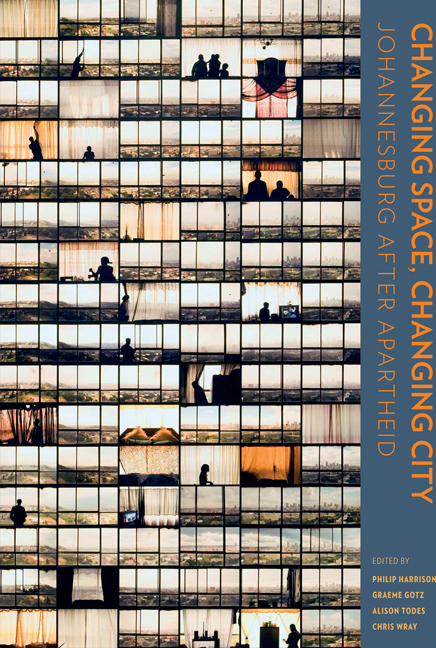Book contents
- Frontmatter
- Contents
- Preface
- Cartography
- 1 Materialities, subjectivities and spatial transformation in Johannesburg
- Section A The macro trends
- Section B Area-based transformations
- Section C Spatial identities
- 23 Footprints of Islam in Johannesburg
- 24 Being an immigrant and facing uncertainty in Johannesburg: The case of Somalis
- 25 On ‘spaces of hope’: Exploring Hillbrow's discursive credoscapes
- 26 The Central Methodist Church
- 27 The Ethiopian Quarter
- 28 Urban collage: Yeoville
- 29 Phantoms of the past, spectres of the present: Chinese space in Johannesburg
- 30 The notice
- 31 Inner-city street traders: Legality and spatial practice
- 32 Waste pickers/informal recyclers
- 33 The fear of others: Responses to crime and urban transformation in Johannesburg
- 34 Black urban, black research: Why understanding space and identity in South Africa still matters
- Contributors
- Photographic credits
- Acronyms
- List of plates
- List of figures
- List of tables
- Index
28 - Urban collage: Yeoville
from Section C - Spatial identities
Published online by Cambridge University Press: 20 April 2018
- Frontmatter
- Contents
- Preface
- Cartography
- 1 Materialities, subjectivities and spatial transformation in Johannesburg
- Section A The macro trends
- Section B Area-based transformations
- Section C Spatial identities
- 23 Footprints of Islam in Johannesburg
- 24 Being an immigrant and facing uncertainty in Johannesburg: The case of Somalis
- 25 On ‘spaces of hope’: Exploring Hillbrow's discursive credoscapes
- 26 The Central Methodist Church
- 27 The Ethiopian Quarter
- 28 Urban collage: Yeoville
- 29 Phantoms of the past, spectres of the present: Chinese space in Johannesburg
- 30 The notice
- 31 Inner-city street traders: Legality and spatial practice
- 32 Waste pickers/informal recyclers
- 33 The fear of others: Responses to crime and urban transformation in Johannesburg
- 34 Black urban, black research: Why understanding space and identity in South Africa still matters
- Contributors
- Photographic credits
- Acronyms
- List of plates
- List of figures
- List of tables
- Index
Summary
Johannesburg, with its origins in the fantasy of instant wealth, expresses its history in various, and oft en contradictory ways. The city is young, built in the late nineteenth century on the promise of the goldmines, giving it a sense of constant reinvention that still defines the city today. Sometimes, in certain places or even just in certain lights, it feels as though Johannesburg is wiping its slate clean. The physical structures remain, giving much of the urban centre a particularly retro 1950s/1960s look; but life moves so fast, neighbourhoods change so rapidly, and memory is erased so easily that it becomes difficult to read these concrete remains as genuine traces of a past. Parts of the urban landscape feel like backdrops to an increasingly surreal and fast-moving film. Other parts of the city feel like a facade, a stage set – faux-Tuscan townhouses, sprawling suburban malls, low-cost state-subsidised housing arranged in neat rows on otherwise bare land – as though, with the wind in your favour, you could push the whole edifice over with one hand.
In another sense, though, as much as Johannesburg has a reputation for erasure, it also has a powerful sense of sedimentation. The city's change takes the form of layers being added to layers: new imagery colonising old landscapes; new means of living and making a life creating new biographies for the 1950s multi-storey office suites; the urban grid with its cute three-bedroomed 1930s houses and small art deco apartment blocks; the industrial warehouses turning into hipster art galleries.
So Johannesburg's memory is constantly erased and remade, but is also visible everywhere. Layers are added, scraped off, painted, carried away to be reconstructed elsewhere; the iconic mine dumps grow, then shrink as they are reprocessed for their last few ounces of gold; the Rissik Street Post Office loses its interior to fire, then grows a new facade of scaffolding; the Albert Street pass office's deserted post-apartheid corridors become home to a women's shelter; old medical suites in the CBD empty out, are repurposed into multi-story retail meccas and Ethiopian coffee houses. Old spaces adopt new layers of the city's imagining of itself.
- Type
- Chapter
- Information
- Changing Space, Changing CityJohannesburg after apartheid, pp. 506 - 511Publisher: Wits University PressPrint publication year: 2014



